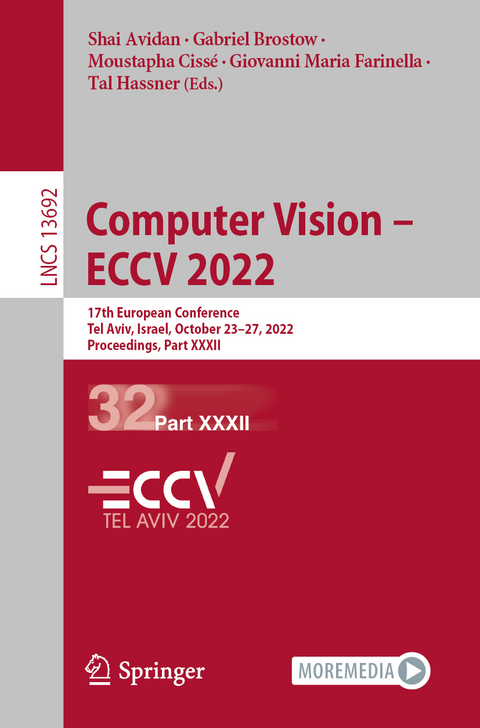
Computer Vision – ECCV 2022
Springer International Publishing (Verlag)
978-3-031-19823-6 (ISBN)
The 39-volume set, comprising the LNCS books 13661 until 13699, constitutes the refereed proceedings of the 17th European Conference on Computer Vision, ECCV 2022, held in Tel Aviv, Israel, during October 23-27, 2022.
The 1645 papers presented in these proceedings were carefully reviewed and selected from a total of 5804 submissions. The papers deal with topics such as computer vision; machine learning; deep neural networks; reinforcement learning; object recognition; image classification; image processing; object detection; semantic segmentation; human pose estimation; 3d reconstruction; stereo vision; computational photography; neural networks; image coding; image reconstruction; object recognition; motion estimation.
ARAH: Animatable Volume Rendering of Articulated Human SDFs.- ASpanFormer: Detector-Free Image Matching with Adaptive Span Transformer.- NDF: Neural Deformable Fields for Dynamic Human Modelling.- Neural Density-Distance Fields.- NeXT: Towards High Quality Neural Radiance Fields via Multi-Skip Transformer.- Learning Online Multi-sensor Depth Fusion.- BungeeNeRF: Progressive Neural Radiance Field for Extreme Multi-Scale Scene Rendering.- Decomposing the Tangent of Occluding Boundaries according to Curvatures and Torsions.- NeuRIS: Neural Reconstruction of Indoor Scenes Using Normal Priors.- Generalizable Patch-Based Neural Rendering.- Improving RGB-D Point Cloud Registration by Learning Multi-Scale Local Linear Transformation.- Real-Time Neural Character Rendering with Pose-Guided Multiplane Images.- SparseNeuS: Fast Generalizable Neural Surface Reconstruction from Sparse Views.- Disentangling Object Motion and Occlusion for Unsupervised Multi-Frame Monocular Depth.- Depth Field Networks for Generalizable Multi-View Scene Representation.- Context-Enhanced Stereo Transformer.- PCW-Net: Pyramid Combination and Warping Cost Volume for Stereo Matching.- Gen6D: Generalizable Model-Free 6-DoF Object Pose Estimation from RGB Images.- Latency-Aware Collaborative Perception.- TensoRF: Tensorial Radiance Fields.- NeFSAC: Neurally Filtered Minimal Samples.- SNeS: Learning Probably Symmetric Neural Surfaces from Incomplete Data.- HDR-Plenoxels: Self-Calibrating High Dynamic Range Radiance Fields.- NeuMan: Neural Human Radiance Field from a Single Video.- TAVA: Template-Free Animatable Volumetric Actors.- EASNet: Searching Elastic and Accurate Network Architecture for Stereo Matching.- Relative Pose from SIFT Features.- Selection and Cross Similarity for Event-Image Deep Stereo.- D3Net: A Unified Speaker-Listener Architecture for 3D Dense Captioning and Visual Grounding.- CIRCLE: Convolutional Implicit Reconstruction and Completion for Large-Scale Indoor Scene.- ParticleSfM: Exploiting Dense Point Trajectories for Localizing Moving Cameras in the Wild.- 4DContrast: Contrastive Learning with Dynamic Correspondences for 3D Scene Understanding.- Few 'Zero Level Set'-Shot Learning of Shape Signed Distance Functions in Feature Space.- Solution Space Analysis of Essential Matrix Based on Algebraic Error Minimization.- Approximate Differentiable Rendering with Algebraic Surfaces.- CoVisPose: Co-Visibility Pose Transformer for Wide-Baseline Relative Pose Estimation in 360° Indoor Panoramas.- Affine Correspondences between Multi-Camera Systems for 6DOF Relative Pose Estimation.- GraphFit: Learning Multi-Scale Graph-Convolutional Representation for Point Cloud Normal Estimation.- IS-MVSNet: Importance Sampling-Based MVSNet.- Point Scene Understanding via Disentangled Instance Mesh Reconstruction.- DiffuStereo: High Quality Human Reconstruction via Diffusion-Based Stereo Using Sparse Cameras.- Space-Partitioning RANSAC.
| Erscheinungsdatum | 13.11.2022 |
|---|---|
| Reihe/Serie | Lecture Notes in Computer Science |
| Zusatzinfo | LVI, 741 p. 282 illus., 273 illus. in color. |
| Verlagsort | Cham |
| Sprache | englisch |
| Maße | 155 x 235 mm |
| Gewicht | 1205 g |
| Themenwelt | Informatik ► Grafik / Design ► Digitale Bildverarbeitung |
| Informatik ► Theorie / Studium ► Künstliche Intelligenz / Robotik | |
| Schlagworte | Applications • Computer Science • conference proceedings • Informatics • Research |
| ISBN-10 | 3-031-19823-9 / 3031198239 |
| ISBN-13 | 978-3-031-19823-6 / 9783031198236 |
| Zustand | Neuware |
| Haben Sie eine Frage zum Produkt? |
aus dem Bereich


